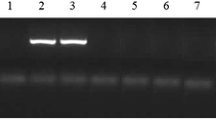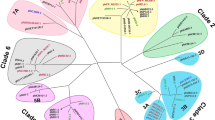Abstract
The aim of this study was to use MboI restriction of pta gene fragment to compare the strains of Staphylococcus aureus phage type 187 and other phage types of S. aureus isolated from humans and dogs, as well as canine S. intermedius group strains. The study included 395 human and canine staphylococcal strains representing S. aureus, S. intermedius, and S. pseudintermedius species. The strains were identified with classic phenotypic methods and by the presence of species-specific thermostable nuclease (nuc SA) gene. All the strains were subjected to the analysis of MboI restriction site of pta gene fragment with PCR–RFLP method. Nearly, all human and animal strains of S. aureus possessed 156- and 164-bp restriction fragments. One of the human strains lacked the 320-bp amplification product. In the case of all S. aureus phage type 187, the amplification product of pta gene was insusceptible to cutting with MboI restrictase. None of S. intermedius strains possessed restriction sites present in the product of amplification of pta gene, while all the strains of S. pseudintermedius had 213- and 107-bp restriction fragments. In conclusion, our findings regarding S. aureus phage type 187 reveal that within the population of strains of S. aureus species, these bacteria represent a group with distinct properties.

Similar content being viewed by others
References
Bannoehr J, Franco A, Iurescia M, Battisti A, Fitzgerald JR (2009) Molecular diagnostic identification of Staphylococcus pseudintermedius. J Clin Microbiol 47:469–471
Baron F, Cochet MF, Pellerin JL, Ben Zakour N, Lebon A, Navarro A, Proudy I, Le Loir Y, Gautier M (2004) Development of a PCR test to differentiate between Staphylococcus aureus and Staphylococcus intermedius. J Food Prot 67:2302–2305
Blair JE, Williams RE (1961) Phage typing of staphylococci. Bull World Health Organ 24:771–784
Garbacz K, Zarnowska S, Piechowicz L, Haras K (2012) Staphylococci isolated from carriage sites and infected sites of dogs as a reservoir of multidrug resistance and methicillin resistance. Curr Microbiol. doi:10.1007/s00284-012-0254-9
Hajek V (1976) Staphylococcus intermedius, a new species isolated from animals. J Syst Bacteriol 26:401–408
Hajek V, Marsalek E (1976) Evaluation of classificatory criteria for staphylococci. In: Jeliaszewicz J (ed) Staphylococci and staphylococcal infections. S. Karger, Hague, pp 30–37
Krynski S, Becla E, Pytasz Z, Malanowski J (1981) Mass carrier state of Staphylococcus aureus type 187 of canine origin in a neonatal ward. Przegl Epidemiol 35:517–520
Kryński S, Galiński J, Becla E (1976) Phage type 187 as a separate taxonomic subunit within the Staphylococcus aureus species. In: Jeliaszewicz J (ed) Staphylococcus and Staphylococcal Diseases. Gustav FIsher Verlag, Stuttgart, New York, pp 57–62
Krzywińska E, Piechowicz L, Galiński J (1999) Prevalence of phage group II in Staphylococcus aureus human strains. Med Dośw Mikrobiol 51:25–30
Live I (1973) Relationship of antigen k to Staphylococcus aureus bacteriophage type 187, of human and of canine origins. Infect Immun 7:473–475
Miedzobrodzki J, Kasprowicz A, Bialecka A, Jaworska O, Polakowska K, Wladyka B, Dubin A (2010) The first case of a Staphylococcus pseudintermedius infection after joint prosthesis implantation in a dog. Pol J Microbiol 59:133–135
Oeding P (1974) Cellular antigens of staphylococci. Ann N Y Acad Sci 236:15–21
Parker MT (1983) The significance of phage-typing patterns in Staphylococcus aureus. In: Easmon CSF, Adlam C (eds) Staphylococci and staphylococcal disease, vol 1. Academic Press, London, pp 33–62
Piechowicz L, Galinski J, Dajnowska-Stanczewa A, Garbacz K (2005) Phage types of Staphylococcus aureus isolated in Poland in 1999–2004. Med Dosw Mikrobiol 57:105–113
Piechowicz L, Garbacz K, Galinski J (2008) Staphylococcus aureus of phage type 187 isolated from people occurred to be a genes carrier of eneterotoxin C and toxic shock syndrome toxin-1 (TSST-1). Int J Hyg Environ Health 211:273–282
Renneberg J, Rosdahl VT (1992) Epidemiological studies of penicillin resistance in Danish Staphylococcus aureus strains in the period 1977–1990. Scand J Infect Dis 24:401–409
Sasaki T, Kikuchi K, Tanaka Y, Takahashi N, Kamata S, Hiramatsu K (2007) Reclassification of phenotypically identified Staphylococcus intermedius strains. J Clin Microbiol 45:2770–2778
Slettemeås JS, Mikalsen J, Sunde M (2010) Further diversity of the Staphylococcus intermedius group and heterogeneity in the MboI restriction site used for Staphylococcus pseudintermedius species identification. J Vet Diagn Invest 5:756–759
Yoon JW, Lee KJ, Lee SY, Chae MJ, Park JK, Yoo JH, Park HM (2010) Antibiotic resistance profiles of Staphylococcus pseudintermedius isolates from canine patients in Korea. J Microbiol Biotechnol 20:1764–1768
Youn JH, Koo HC, Ahn KJ, Lim SK, Park YH (2011) Determination of staphylococcal exotoxins, SCCmec types, and genetic relatedness of Staphylococcus intermedius group isolates from veterinary staff, companion animals, and hospital environments in Korea. J Vet Sci 12:221–226
Author information
Authors and Affiliations
Corresponding author
Rights and permissions
About this article
Cite this article
Garbacz, K., Piechowicz, L. Phage Type 187 as a Separate Subunit MboI Restriction Site Within the Staphylococcus aureus Species. Curr Microbiol 66, 578–581 (2013). https://doi.org/10.1007/s00284-013-0319-4
Received:
Accepted:
Published:
Issue Date:
DOI: https://doi.org/10.1007/s00284-013-0319-4




